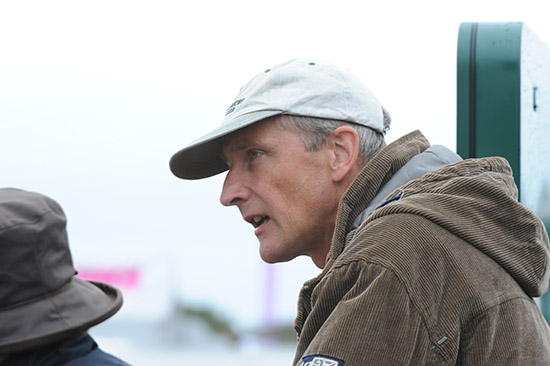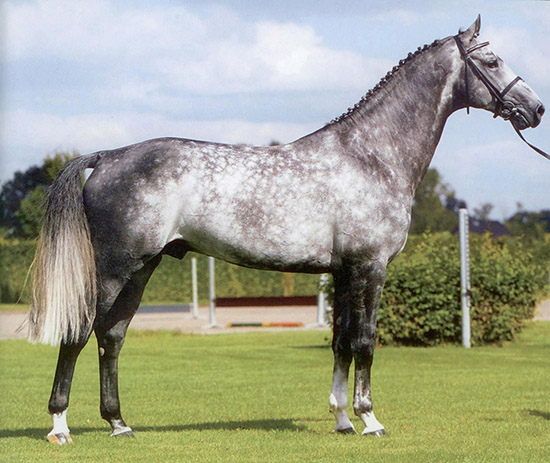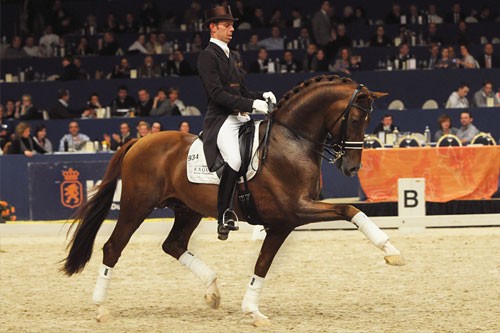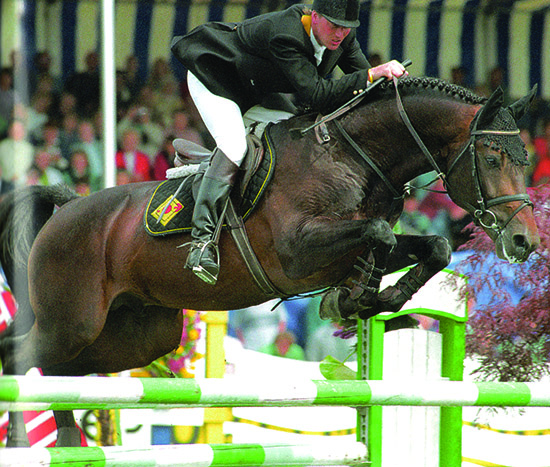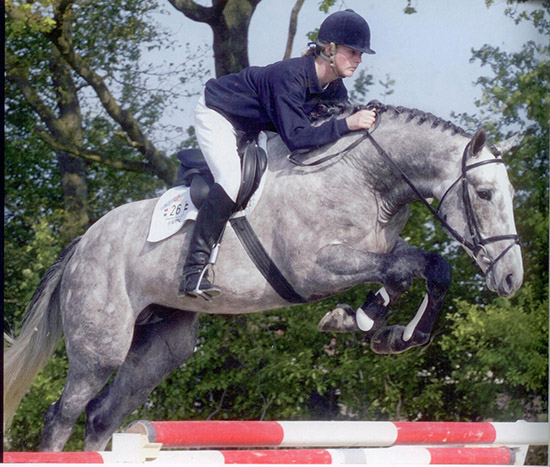Dirk Willem Rosie worked for the KWPN from 1994 to 2006. During this period he was the editor-in-chief of the Dutch equestrian magazine, De Strengen. He is the author of the recently published book, Selecting the Dressage Horse (published by J A Allen). Not surprisingly, Dirk is an enthusiastic observer of the Dutch breeding scene:
“I suppose the most positive development would be the eagerness of the breeders to find the best – where-ever it is – without just relying on Dutch blood. There are some very good young stallions that the KWPN has developed over the years, who have come through the performance test but it is also important to look for super sport stallions with super pedigrees over the borders, in Germany, in France. The search for the best genetic material goes on within Holland but also internationally – and that is the big strength of Dutch breeding.”
More successful at breeding jumping horses than dressage horses?
“If you look at the figures, yes, obviously, and the search for the special pedigrees is very strong in jumping breeding – Baloubet, Quidam de Revel, Cassini – but I think we are going to produce a lot of very good dressage horses in the near future. Dressage has been a problem. It is a relatively weak spot compared to showjumping but I’ve seen a lot of very good dressage horses coming on in Holland, and I think we can gain some ground there.”
Do you think the problem is that the Dutch Warmblood is largely Holsteiner influenced? Great jumpers but with a tendency to be slow and out behind in the trot…
“I couldn’t blame it on the influence of Holstein. It is always a comparison. If you compare it to what Hanover has done over the last few decades, there you see a true search for the functional dressage model, and a couple of very consolidated, homogenous lines – the ‘B’ line, the ‘W’ line – and it is very hard to compete with that pureness in breeding that Hanover has developed in 300 years of breeding. Their pureness in breeding is really hard to beat. I don’t think we need to concentrate on one aspect, the use of the hindquarters, to explain the fact that we have trailed behind Hanover. I think you should turn it around a little: it is very good to be second behind such an outstanding breeding region – while still being first with the same population, in jumping. That’s quite hard and it is a very good development that we have split the populations in Holland so we can focus on competition with the showjumpers from Holstein, France and Belgium, and focus on competition with dressage horses from Hanover and Westfalia.”
It is interesting that now in Hanover they are having a re-think, and they are now coming around to the view that some jumping blood helps in the making of a dressage horse, we see more and more, young stallions that are successful in the world of dressage, that have some jumping blood on the bottom line…
“You will find jumping blood in any pedigree, if you go down the lines you will find a lot of jumping blood in what are now dressage horses, but that is not really relevant in my opinion. You have to look at the development, and the development goes to dressage horses regardless of their background, whether it is from Thoroughbred lines, or whatever, they develop into dressage horses – and you shouldn’t make the mistake of going back in pedigrees and Hey! There we find one of two stallions of showjumping origin, and the draw the conclusion, now we should import showjumping blood in dressage breeding. I think you should really look for the traits, how horses canter, what is the posture of the horse, how their minds are, and you should adapt for what you see, and that doesn’t mean going back to jumper blood. If Hanover feels that way, wonderful, let them try Stakato…”
No, no, no, they make it clear that it has to be certain lines of jumpers and horses like Stakato, or the French horses, would be very unsuitable, but that it is necessary to add in a little jumping blood – of the right sort – every now and then to keep the canter and the athleticism…
“That’s a discussion that we hear a lot and there is only one thing I can say to that – it is a very different thing to breed dressage to dressage than to breed big trot to big trot. If you do that, then you are not a good breeder – you are not a specialist breeder, you are just a bad breeder, because big trot is a problem as it is. Maybe you need it sometimes, the lengthening of the pace and the power in trot, but it is a quality that turns into a defect if you have too much of it. What is happening with a lot of commercial breeders is that they only look for the big pace in trot and they are just bad breeders. But that is not a reason to condemn specialisation in breeding, it is just bad breeding. If you have a big trotting mare, then you should add functional movement, and sometimes you may need our stallion Odermus who is a Calido, Ramiro, Joost, so he has a lot of jumping genetics, but he is also and upward built horse with functional movement, a lot of rhythm, very good canter. So if you had a very big trotting mare, you are better to use a stallion like Odermus. Even though he has a jumping pedigree he acts like a dressage horse in some ways, because he is built like a dressage horse, he canters superbly – I wouldn’t say, then you are breeding a dressage mare to a showjumping stallion, no you are breeding a dressage mare to a stallion that improves the dressage abilities of the mare.”
Odermus – jumping blood, dressage movement
Which are the most important dressage stallions that are currently standing in Holland?
“We have a few very talented sons of Jazz, who I think are better than their father. Jazz is a top stallion with lots of offspring competing Grand Prix, he improves the posture and the conformation of the dressage horse, and he improves the trot, but he is not as good in canter, and we have a couple of his sons – Winton and Westpoint – they have better canter and they also have the good qualities of Jazz. After that it is difficult to come up with names…
It’s interesting, in any breeding population when we go searching for dressage stallions, they are difficult to find but if we go to jumping stallions, there are hundreds of equally good stallions…
“You are right, the dressage sires are harder to find. One more is Vivaldi, a son of Krack. The same thing, better than the father. Krack lacks a bit of power from behind, and his son Vivaldi has all the power and has an excellent conformation for a dressage horse. I would use him for a lot of mares – he gives long legs, long lines, power from behind and wonderful balance. But as I said earlier, we need foreign breeding as well to improve our breeding – we are not good enough to do it all by ourselves.”
Vivaldi – the son is better than the father…
“There are others: Negro, a son of Ferro, not used enough but a wonderful stallion. I would breed him to a more long legged mare because there is always a danger of short legs with Ferro. I think Negro is one of the best sons of Ferro. Rousseau was sold to America, but he is a wonderful stallion, and we still have some frozen semen from him – he does wonderful things. We have some good sons of the famous stallions, Jazz, Ferro, that can add even more quality because they have stronger points where their sires have weaker points.”
So what lines from Germany work well in Holland?
“The better sons of Donnerhall, that’s what we need.”
Has Sandro Hit worked in Holland?
“No. But you shouldn’t condemn Sandro Hit too hard because he has improved a few important things – athleticism, use of the forehand, expression in the forehand, and I think they have good minds, I think they are very rideable as long as you don’t take them too far… if you go to the levels where they are not comfortable, then of course, they start to resist. But in Holland we have only had the ones that are slow behind. I would prefer Diamond Hit, the Donnerhall version of Sandro Hit, the same mother. Diamond Hit has the functional quality of Donnerhall combined with the athleticism and the blood and the brilliance of the dam line. It’s the better sons of Donnerhall that we need.”
Do you have the same problem in Holland that they have in Germany where the breeders are trying to breed horses that win the young horse classes and not for top sport?
“This is a problem in general, you cannot blame the Germans or the Dutch. It is natural for a judge to chose a nice aesthetic picture, and to not chose the functional – I call it knitting machine, you know they go up and down – horses that have a lot of vertical movement and if you look closely, a lot of potential for piaffe / passage / pirouette. They only need to lengthen their strides which is easy in training, it is just the lengthening of the moment of suspension, it is the easiest thing to do if you are a good trainer.
What happens is that these commercial types get the advantage when they are young and it is hard to be a judge and say ‘no, I don’t like the beautiful horse there, I’d rather have the functional one from over there’. You get the boos from the audience and all that. But I think there is a responsibility for judges throughout the world to teach the spectators and breeders what to look for, and where the functionality of a dressage horse lies. You can see those qualities, it’s harder to see them but they are there. I’ve seen horses fail in the Parvo Cup for Young Horses, that are now winning Grand Prix in America because they were knitting machines. Ravel – who will go to Hong Kong with the American Team – he was expelled from the Parvo Cup because he was like that. There are many examples of where judges would have to stand up and say to the audience – this is the winner – most people don’t disagree, the winner is obvious, but the horses from three to five that should be more functional, and teach the spectators and breeders how to look for the functional elements of the dressage horse.”
Has the Parvo Cup become as dominating in Holland as the Bundeschampionate in Germany?
“It is decisive for stallions to go well there and attract mares and breeders.”
Is there the same tendency, more and more the breeders go to the young stallions that starred in the licensing or young horse classes, and the older stallions find it difficult to get mares?
“That is the tendency in breeding in general, there is always the gap between being young and attractive and promising and the stage where they have really proven themselves through offspring or their own record in sport. What we see now are that there two lots of stallions that attract the bulk of the mares – the younger stallions that are promising, and the really proven ones. It is amazing that Jazz has been covering more that 350 mares this year – while he has such promising young sons. The same goes for Gribaldi. There is a big return to the proven sires in Holland.”
In Germany there is a feeling that breeders are trying to produce very attractive foals for the Foal Auctions, but these are not necessarily the best types for riding later on…
“There has been criticism, even as high as the KWPN stallion commission, who criticise Dutch breeders who use stallions only to make a lot of money at foal auctions. I do not fully agree. I think the development in Germany is a little bit more commercial than in Holland. The selection commissions in Holland really look for a broad variety of pedigrees, and there is no mechanism for promoting a certain stallion through auctions, in Holland. So this is not a big problem for our breeders.”
“The bigger problem is the judging of young dressage horses: Parvo Cup, Bundeschampionate, that is where the judges should teach the breeders.”
What have been the most important jumping sires in Holland of recent times?
“We are now developing our own lines, which is new. As Hanover has been growing through more purity in breeding for dressage, Holstein was very pure in breeding for jumping, far more pure than Holland. Looking at our Dutch stallions, ten or twenty years ago, it was very hard to find stallions that went on to establish a stallion line. Now we have a few. For example the sons of Concorde are probably even better than their father. Numero Uno, who is doing very well, he has some very promising sons – so Libero is really a foundation sire and Numero Uno has taken over his role and will develop into a foundation sire. These developments within Holland are essential but we keep looking for the best blood in Holland or France, the best from anywhere in the world.”
Libero – a foundation sire for Dutch jumping
French blood was very important early in Dutch breeding and then it seemed to go out of fashion, and the trend was to go to Holstein exclusively – has there been a move back to France, to Quidam, to Baloubet?
“Not really a return to France, but it is true Le Tot de Semilly is used more in Holland now. Joop Van Uyert purchased a share in the 2007 Holstein stallion licensing champion, Diarado, by Diamant de Sémilly, and he breeds a lot in Holland. You cannot say that France has come more into fashion in Holland, it is just aimed at individual stallions that attract breeders. You cannot say that Holland is dominated by Holstein either, it is linked to each individual stallion. You use more Holstein because in general, Holstein stallions are a little bit better than the French ones. But look at Silverstone, who is by Champion du Lys out of a Carthago mare, these mixed pedigrees, they work out very well in Holland. We do not need a Holstein mare to go to a French stallion, or the other way round, in order to get the outcross effect – we are way further than that – now we just look to the individual talent of a stallion, and when we need it, we use it.”
Silverstone by a grandson of the French stallion, Mexico out of a Capitol / Ramiro bred mare – the mixed pedigrees work in Holland
We’ve looked at the strengths what are the weakness that confront Dutch breeding?
“The problem would not lie in the genetic field. We could do some stupid things about osteocondrosis.”
But the Dutch were the first to take action against this condition?
“Yes, but we are now amongst the first to loosen the regime. We have developed breeding values for osteocondrosis. We did a population scan and now we are comparing the offspring of young stallions with the average of the population, so we can produce breeding values, and what I am very curious about is how the breeding policy develops. The intention is to publish the breeding values of the stallions for osteocondrosis, so we can let in stallions with only osteocondrosis, not the desicans version, not the chip version, but I don’t want the breeding to become too easy on osteocondrosis, it is still something we have to fight. I think we have choice enough, and quality enough, to maintain a strict line, but I am not sure whether the KWPN will choose the strict line. I’m very positive about the osteocondrosis project, but it should not lead to new problems with soundness. I think we should maintain the strict line. If we can use the stallions with only the osteocondrosis version, and not get into trouble, then okay, but I am not sure whether that will work out. It is something we have to closely follow.”
In general the future is bright?
“Absolutely. We are a funny country, we are a small piece of land with a lot of people, a lot of events and a lot of attention and focus – and that is really our biggest strength compared to Australia or America where there is a breeder over there and 100s of kilometres away there is another breeder and they don’t even meet. In Holland everybody follows everything, so there is a lot of knowledge being spread around the whole population of breeders. The knowledge of our breeders is higher than anywhere in the world, and we have a broader view. I live in Germany now, and I find that Westfaliens are still Westfaliens, and Holsteins are still Holsteins. That has a positive side because the Holsteiner is one of the few horses that are recognizable in their phenotype, and that has an advantage – but I like the openness of Dutch breeding better because it is decided in the ring who wins, no-body looks at any pedigree, just the best wins. I like that, open competition is always better than borders and restrictions. I think Holland has the best future because we are open minded.”
You were saying that you thought there is now more knowledge amongst the breeders, and yet the general complaint is that the old knowledgeable breeders are leaving and the new breeders don’t know what they are doing…
“I don’t think so. Of course there has been a generation change from the farm kind of breeding to the modern type of breeding, and change always comes with problems. I think we have the advantage in Holland of being so small with a lot of focus, a lot of knowledge being spread around, so we are better equipped to handle this change of generation than a big country would be. What I find is a better focus on sport. Obviously new people come in, now in Holland we have half a million people involved with horses which is five times more than 25 years ago. Obviously they are all new people, they don’t come from farms but they have qualities and you have to pick up on the good things they bring: enthusiasm, money, ambition, if you pick that up and work with that, and teach them, then we can make progress. That is what we’ve proved in Holland with the new breeders, I don’t think it’s a problem, it’s a challenge and can be met with education and understanding.”
“The breeders are becoming less dependent on the breeding management of the KWPN, and they are relying more on their own opinions and views whereas in the old days, breeders were very obedient and really did what the breeding management told them to do. Now people are freer and more open minded and more critical and they stand up for their own views.”

